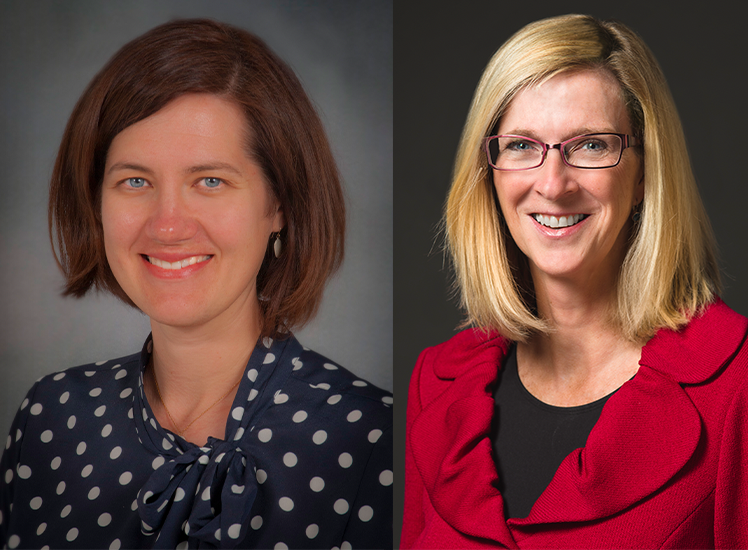
Cerebral palsy (CP) is a non-progressive condition where the abnormality of movement or posture is caused by an injury during the neo-natal period or by an anomaly of the brain. Since these injuries to the brain happen early in life, it is important for doctors to be able to recognize symptoms of cerebral palsy at the youngest age possible in order to intervene and help correct the muscle network.
Principal investigators Betsy Ostrander, MD, and Sarah Winter, MD, from University of Utah Health and Intermountain Primary Children's, are conducting an ongoing study through the NICU at U of U Health and the Neonatal Follow-up Program (NFP). In collaboration with institutions across the country, they were able to find ways to reduce the age of diagnosis for cerebral palsy from 19.5 months to 9.5 months.

“Generally, we don’t think of CP as a condition that gets worse,” says Winter, professor in the Division of General Pediatrics and medical director of NFP. “Rather, could we do something early on to help the child function better?”
“In the past, we knew babies were at risk for movement difficulties because they may have been born premature or have had brain injury,” says Ostrander, assistant professor in the Department of Pediatrics and director of Fetal and Neonatal Neurology Program at U of U Health. “But now we can identify with more certainty precisely which babies are at highest risk. This allows us to provide education to parents, start therapies early that may improve outcomes, and make sure we are following their development closely."
Ostrander and Winter describe more about the study and why it is important.
Why is an early diagnosis so important?
Standardized tests allow us to see things and be confident of our findings at 9 months that we were not confident of before. The earlier the diagnosis, the better the possibility of improved outcome because the brain is so ready for intervention when children are little. It takes advantage of the rapidly developing brain and changes the neural pathways in babies to help them move better. This is also known as optimizing neuroplasticity.
This research makes a huge difference for parents, too. They want to know as soon as doctors know that there is a concern. When you are a parent of a baby with CP, waiting for a diagnosis seems like an eternity.
How do injuries to the brain happen at an early stage?
CP can develop if the child had an injury to the brain or was born prematurely. Children may also have cerebral palsy due to genetic disorders. They are also at high risk if they are born very pre-term. We are following those children closely, using these tools to figure out if they have CP.
What kind of interventions can you start implementing at 9.5 months to make a difference?
Physical therapy enhances effective infant movement patterns from a young age. It’s basically playing with the baby in a therapeutic manner.
Stretching, tummy-time, learning to visually track, and reaching for toys are all typical infant activities but all of these movements are essential to developing neural pathways. We can’t cure this disorder, but we can help children to be as functional and successful as possible. Our goal is to connect families with resources as early as possible so that we can maximize their child’s development.
How did the team carry out the study?
The research was carried out at five sites across the country. Each of the university settings implemented the standardized evaluations of infants in the neonatal intensive care unit (NICU) and in follow-up clinics. Each university has a different system to evaluate babies at risk of brain injuries, while simultaneously taking recommendations from each other and trying to implement standardized tools in motor development.
The collaboration takes advantage of each setting’s strengths and the partnership of the entire group, to decrease the age of diagnosis.
How were the evaluations done?
There are evidence-based standardized measures for cerebral palsy including looking for writhing movements in a young baby and fidgety movements in a 3-month-old. MRI brain images assist with diagnosis and finding injuries and anomalies.
Video can show some of the worrisome movements that trained therapists and physicians can evaluate. The tool is called the General Movements Assessment and the baby is recorded lying down for two to three minutes. Parents can record and send the videos to the providers.
Another tool is the Hammersmith Infant Neurologic Exam (HINE), which is used in babies aged between 2 and 24 months. It involves obtaining 26 different movements with the baby and providing a total score. That score can be correlated to determine whether the baby’s movements can be classified as “at-risk” for cerebral palsy or are “reassuring.”
What are the future directions for your research?
The research is still ongoing. In the first year, we were able to determine that early diagnosis of CP was possible. In our second and third year, we hope to expand the process across the state, including at other Intermountain Healthcare NICUs in the northern and southern parts of Utah.